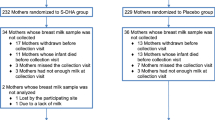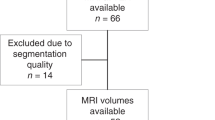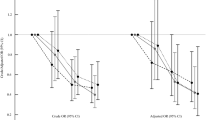Abstract
A double-blind, randomized, controlled, parallel-group prospective trial was conducted to determine whether a dose-response existed for four different levels of docosahexaenoic acid (DHA) supplementation on the cognitive performance of infants. A total of 122 term infants were fed one of four different formulas varying in their DHA composition (0.00, 0.32, 0.64, and 0.96% of total fatty acids as DHA) from birth to 12 mo. The three DHA-supplemented formulas also contained 0.64% of total fatty acids as arachidonic acid (ARA, 20:4n-6). Infants were tested at 4, 6, and 9 mo of age on a visual habituation protocol that yielded both behavioral and psychophysiological indices of attention. Infants in all DHA+ARA-supplemented conditions had lower heart rates than those in the unsupplemented condition; there was no dose-response for this effect. The distribution of time that infants spent in different phases of attention (a cognitive index derived from the convergence of behavioral and cardiac responses) varied as a function of dosage. Infants supplemented at the two lower DHA doses spent proportionately more time engaged in active stimulus processing than infants fed the unsupplemented formula, whereas infants fed the highest dose were intermediate and did not differ from any other group.
Similar content being viewed by others
Log in or create a free account to read this content
Gain free access to this article, as well as selected content from this journal and more on nature.com
or
Abbreviations
- ARA:
-
arachidonic acid
- AT:
-
attention termination
- bpm:
-
beats per minute
- DHA:
-
docosahexaenoic acid
- HR:
-
heart rate
- LCPUFA:
-
long-chain polyunsaturated fatty acids
- OR:
-
orienting
- SA:
-
sustained attention
References
Clandinin MT, Chappell JE, Leong S, Heim T, Swyer PR, Chance GW 1980 Extra-uterine fatty-acid accretion in infant brain: implications for fatty-acid requirements. Early Hum Dev 4: 131–138
Martínez M, Mougan I 1998 Fatty acid composition of human brain phospholipids during normal development. J Neurochem 71: 2528–2533
Farquharson J, Jamieson EC, Abbasi KA, Patrick WJ, Logan RW, Cockburn F 1995 Effect of diet on the fatty-acid composition of the major phospholipids of infant cerebral cortex. Arch Dis Child 72: 198–203
Makrides M, Neumann MA, Byard RW, Simmer K, Gibson RA 1994 Fatty-acid composition of brain, retina, and erythrocytes in breast-fed and formula-fed infants. Am J Clin Nutr 60: 189–194
Birch EE, Hoffman DR, Uauy R, Birch DG, Prestidge C 1998 Visual acuity and the essentiality of docosahexaenoic acid and arachidonic acid in the diet of term infants. Pediatr Res 44: 201–209
Carlson SE, Ford AJ, Werkman SH, Peeples JM, Koo WW 1996 Visual acuity and fatty acid status of term infants fed human milk and formulas with and without docosahexaenoate and arachidonate from egg yolk lecithin. Pediatr Res 39: 882–888
Auestad N, Montalto MB, Hall RT, Fitzgerald KM, Wheeler RE, Connor WE, Neuringer M, Connor SL, Taylor JA, Hartmann EE 1997 Visual acuity, erythrocyte fatty acid composition, and growth in term infants fed formulas with long chain polyunsaturated fatty acids for one year. Pediatr Res 41: 1–10
Jensen CL, Prager TC, Fraley JK, Chen HM, Anderson RE, Heird WC 1997 Effect of dietary linoleic/alpha-linolenic acid ratio on growth and visual function of term infants. J Pediatr 131: 200–209
Innis SM, Akrabawi SS, Diersen-Schade DA, Dobson MV, Guy DG 1997 Visual acuity and blood lipids in term infants fed human milk or formulae. Lipids 32: 63–72
Carrié I, Clément M, De Javel D, Francès H, Bourre JM 1999 Learning deficits in first generation OF1 mice deficient in (n-3) polyunsaturated fatty acids do not result from visual alteration. Neurosci Lett 266: 69–72
Wainwright PE, Huang YS, Coscina DV, Levesque S, McCutcheon D 1994 Brain-effects and behavioral-effects of dietary n-3 deficiency in mice: a 3-generational study. Dev Psychobiol 27: 467–487
Stevens LJ, Zentall SS, Abate ML, Kuczek T, Burgess JR 1996 Omega-3 fatty acids in boys with behavior, learning, and health problems. Physiol Behav 59: 915–920
Willatts P, Forsyth JS 2000 The role of long-chain polyunsaturated fatty acids in infant cognitive development. Prostaglandins Leukot Essent Fatty Acids 63: 95–100
Agostoni C, Trojan S, Bellu R, Giovannini M 1995 Neurodevelopmental quotient of healthy term infants at 4 months and feeding practice: the role of long-chain polyunsaturated fatty-acids. Pediatr Res 38: 262–266
Agostoni C, Trojan S, Bellu R, Riva E, Bruzzese MG, Giovannini M 1997 Developmental quotient at 24 months and fatty acid composition of diet in early infancy: a follow up study. Arch Dis Child 76: 421–424
Birch EE, Garfield S, Hoffman DR, Uauy R, Birch DG 2000 A randomized controlled trial of early dietary supply of long-chain polyunsaturated fatty acids and mental development in term infants. Dev Med Child Neurol 42: 174–181
Birch EE, Garfield S, Castaneda Y, Hughbanks-Wheaton D, Uauy R, Hoffman D 2007 Visual acuity and cognitive outcomes at 4 years of age in a double-blind, randomized trial of long-chain polyunsaturated fatty acid-supplemented infant formula. Early Hum Dev 83: 279–284
Makrides M, Neumann MA, Simmer K, Gibson RA 2000 A critical appraisal of the role of dietary long-chain polyunsaturated fatty acids on neural indices of term infants: a randomized, controlled trial. Pediatrics 105: 32–38
Auestad N, Scott DT, Janowsky JS, Jacobsen C, Carroll RE, Montalto MB, Halter R, Qiu W, Jacobs JR, Connor WE, Connor SL, Taylor JA, Neuringer M, Fitzgerald KM, Hall RT 2003 Visual, cognitive, and language assessments at 39 months: a follow-up study of children fed formulas containing long-chain polyunsaturated fatty acids to 1 year of age. Pediatrics 112: e177–e183
Simmer K, Patole SK, Rao SC 2008 Longchain polyunsaturated fatty acid supplementation in infants born at term. Cochrane Database Syst Rev: CD000376
Beyerlein A, Hadders-Algra M, Kennedy K, Fewtrell M, Singhal A, Rosenfeld E, Lucas A, Bouwstra H, Koletzko B, von Kries R 2010 Infant formula supplementation with long-chain polyunsaturated fatty acids has no effect on Bayley developmental scores at 18 months of age—IPD meta-analysis of 4 large clinical trials. J Pediatr Gastroenterol Nutr 50: 79–84
Colombo J 2002 Infant attention grows up: the emergence of a developmental cognitive neuroscience perspective. Curr Dir Psychol Sci 11: 196–200
Bornstein MH, Sigman MD 1986 Continuity in mental development from infancy. Child Dev 57: 251–274
Colombo J 1993 Infant Cognition: Predicting Later Intellectual Functioning. Sage Publications, Newbury Park, pp. 30–81
Colombo J, Kannass KN, Shaddy DJ, Kundurthi S, Maikranz JM, Anderson CJ, Blaga OM, Carlson SE 2004 Maternal DHA and the development of attention in infancy and toddlerhood. Child Dev 75: 1254–1267
Colombo J, Mitchell DW 2009 Infant visual habituation. Neurobiol Learn Mem 92: 225–234
Casey BJ, Richards JE 1988 Sustained visual-attention in young infants measured with an adapted version of the visual preference paradigm. Child Dev 59: 1514–1521
McLennan PL, Owen AJ, Slee EL, Theiss ML 2007 Myocardial function, ischaemia and n-3 polyunsaturated fatty acids: a membrane basis. J Cardiovasc Med (Hagerstown) 8: S15–S18
Christensen JH, Schmidt EB 2007 Autonomic nervous system, heart rate variability and n-3 fatty acids. J Cardiovasc Med (Hagerstown) 8: S19–S22
Birch EE, Carlson SE, Hoffman DR, Fitzgerald-Gustafson KM, Fu VL, Drover JR, Castaneda YS, Minns L, Wheaton DK, Mundy D, Marunycz J, Diersen-Schade DA 2010 The DIAMOND (DHA Intake And Measurement Of Neural Development) Study: a double-masked, randomized controlled clinical trial of the maturation of infant visual acuity as a function of the dietary level of docosahexaenoic acid. Am J Clin Nutr 91: 848–859
Colombo J, Shaddy DJ, Richman WA, Maikranz JM, Blaga OM 2004 The developmental course of habituation in infancy and preschool outcome. Infancy 5: 1–38
Colombo J, Mitchell DW, O'Brien M, Horowitz FD 1987 The stability of visual habituation during the first year of life. Child Dev 58: 474–487
Colombo J, Mitchell DW 1990 Individual differences in early visual attention: fixation time and information processing. In: Colombo J, Fagen J (eds) Individual Differences in Infancy: Reliability, Stability, Prediction. Lawrence Erlbaum Associates, Hillsdale, NJ, pp 193–227
Colombo J, Horowitz FD 1985 A parametric study of the infant control procedure. Infant Behav Dev 8: 117–121
Richards JE 1985 The development of sustained visual-attention in infants from 14 to 26 weeks of age. Psychophysiology 22: 409–416
Carlson SE, Werkman SH 1996 A randomized trial of visual attention of preterm infants fed docosahexaenoic acid until two months. Lipids 31: 85–90
Richards JE 1987 Infant visual sustained attention and respiratory sinus arrhythmia. Child Dev 58: 488–496
Colombo J, Richman WA, Shaddy DJ, Greenhoot AF, Maikranz JM 2001 Heart rate-defined phases of attention, look duration, and infant performance in the paired-comparison paradigm. Child Dev 72: 1605–1616
Colombo J, Shaddy DJ, Anderson CJ, Gibson LJ, Blaga OM, Kannass KN 2010 What habituates in infant visual habituation? A psychophysiological analysis. Infancy 15: 107–124
Colombo J, Shaddy DJ, Blaga OM, Anderson CJ, Kannass KN, Richman WA 2009 Early attentional predictors of vocabulary in childhood. In: Colombo J, McCardle P, Freund L (eds) Infant Pathways to Language: Methods, Models, and Research Directions. Lawrence Erlbaum Associates, New York, NY, pp 143–167
Calder PC 2004 n-3 fatty acids and cardiovascular disease: evidence explained and mechanisms explored. Clin Sci 107: 1–11
von Schacky C 2004 Omega-3 fatty acids and cardiovascular disease. Curr Opin Clin Nutr Metab Care 7: 131–136
Mozaffarian D, Stein PK, Prineas RJ, Siscovick DS 2008 Dietary fish and omega-3 fatty acid consumption and heart rate variability in US adults. Circulation 117: 1130–1137
Mozaffarian D, Prineas RJ, Stein PK, Siscovick DS 2006 Dietary fish and n-3 fatty acid intake and cardiac electrocardiographic parameters in humans. J Am Coll Cardiol 48: 478–484
Lauritzen L, Christensen JH, Damsgaard CT, Michaelsen KF 2008 The effect of fish oil supplementation on heart rate in healthy Danish infants. Pediatr Res 64: 610–614
Peoples GE, McLennan PL, Howe PR, Groeller H 2008 Fish oil reduces heart rate and oxygen consumption during exercise. J Cardiovasc Pharmacol 52: 540–547
Gustafson KM, Colombo J, Carlson SE 2008 Docosahexaenoic acid and cognitive function: is the link mediated by the autonomic nervous system?. Prostaglandins Leukot Essent Fatty Acids 79: 135–140
Hibbeln JR, Ferguson TA, Blasbalg TL 2006 Omega-3 fatty acid deficiencies in neurodevelopment, aggression and autonomic dysregulation: opportunities for intervention. Int Rev Psychiatry 18: 107–118
Author information
Authors and Affiliations
Corresponding author
Additional information
Supported by Mead Johnson Nutrition, Evansville, IN. Supported also by the University of Kansas Medical Center and by the University of Kansas Intellectual and Developmental Disabilities Research Center, P30 HD002528. Supported in part by grant R01 HD047315 for analyses and preparation of the report.
Rights and permissions
About this article
Cite this article
Colombo, J., Carlson, S., Cheatham, C. et al. Long-Chain Polyunsaturated Fatty Acid Supplementation in Infancy Reduces Heart Rate and Positively Affects Distribution of Attention. Pediatr Res 70, 406–410 (2011). https://doi.org/10.1203/PDR.0b013e31822a59f5
Received:
Accepted:
Issue date:
DOI: https://doi.org/10.1203/PDR.0b013e31822a59f5
This article is cited by
-
Omega-3 fatty acids and autonomic function in adolescents with anorexia: A randomized trial
Pediatric Research (2022)
-
Supplementation of Infant Formula and Neurodevelopmental Outcomes: a Systematic Review
Current Nutrition Reports (2022)
-
Community initiated kangaroo mother care and early child development in low birth weight infants in India-a randomized controlled trial
BMC Pediatrics (2020)
-
Efficacy of novel small-quantity lipid-based nutrient supplements in improving long-chain polyunsaturated fatty acid status of South African infants: a randomised controlled trial
European Journal of Clinical Nutrition (2020)
-
Study protocol: optimized complementary feeding study (OTIS): a randomized controlled trial of the impact of a protein-reduced complementary diet based on Nordic foods
BMC Public Health (2019)



